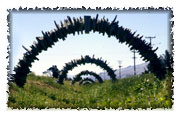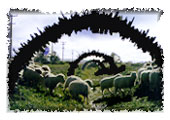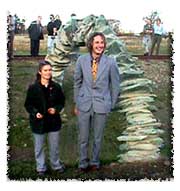
 |
The ArchesMiddlemarchSculpture by Rebecca South and Jesse Stevens |
|||
| What are The Arches? | ||||
 |
The Arches is a large sculpture that resulted from the Dunedin City Council's 'Sculpture in Public Places Policy.' Submissions of a sculpture suitable for the chosen site in the Middlemarch Railway Reserve area were invited from Dunedin artists, resulting in a variety of proposals. These were presented to the community in the consultation process by exhibited these in the local Postal Agency, and by a presentation in person by the artists at the planned site. The final selection was made in consultation with the Middlemarch Community Board and by public vote. . |
|||
| What is the "Sculpture in Public Places" policy? | ||||
 |
Lloyd Edwards, community arts advisor for DCC, cites the policy's goal as "initiating the involvement of art and artists with the community." Lloyd's interest was in facilitating a closer relationships between artists and the community in projects such as the Middlemarch commission, and to add an effective and informed process to achieve a sense of ownership of works within the community. (Courtesy Landscape New Zealand, July/August 1998, p. 28-29) . |
|||
| The artists: | ||||
|
|
Rebecca South and Jesse Stevens were 2nd and 4th year Art School students and had an interest in Public Art. They visited Middlemarch in the winter of 1997 and were inspired to enter the competition for the $5000 commission.
Extracts from their proposal: "After visiting Middlemarch we felt the fundamental issues that needed to be represented in this work were the landscape, the environment and the people."
|
|||
 |
 |
|||
|
|
Integrating into the community: Rebecca and Jesse spent three months living in the community itself during summer while creating the sculpture and connecting with the locals. Comments about this experience by the artists include: "Developing a sense of acceptance within the community and encouraging public participation was crucial to the sculptures success."
|
|||
 |
Landscape New Zealand explains: "The work was a colossal undertaking for the two students and required their integration into the community over three months of summer. The artists had little experience of rural life and culture...the...community [little] awareness of the artistic process. This project demanded a rapid transition for both parties. . |
|||
| The making of The Arches in the words of the artists themselves: | ||||
|
|
We gathered 10 tonnes of rocks from a quarry at Arrowtown with the enormous help of friend, Celia Morgan. We had originally intended to use local rock, but found out that the rust content made it unsuitable. The 80kg key stones we cut and shaped from large blocks with a concrete cutter. To make the two necessary holes wide enough to fit onto the steel reinforcing rods, each rock needed to be drilled six times, increasing the diameter of the hole slightly each time. Concrete foundations and scaffolding were built to support and shape the Arches. |
|||
 |
 |
 |
||
|
|
The rocks were now threaded onto reinforcing rods and strengthened with cement in between. The keystones were lifted into place by both mechanical and home-made cranes. Local residents were generous in assisting us during these difficult maneuvers. Dismantling the scaffolding from the first and largest arch, 2m high and 4m wide, was a nerve racking experience. Thankfully, the arch kept its shape!
In the school holidays, the local children became an important link between us and their parents. Their unbiased curiosity often attracted others over to the site. Several children spent time with us both at the construction site and in our temporary home, sharing everything from our breakfasts to our leisure activities. Heath Frew, a local teenager, assisted with the project daily for nearly two months. We were tremendously grateful for his generous help. |
|||
| .The Official Opening: | ||||
 |
The sculpture was officially opened by members of the Dunedin City Council and the local Community Board chairperson. This image captures the champagne breaking against the largest arch. The opening was followed by a slide show presentation and celebration with a large number of locals and visitors at the Community Centre. |
|||





